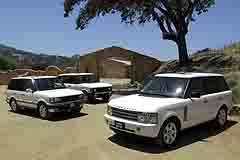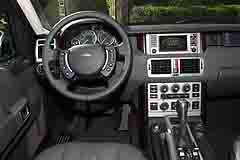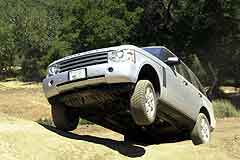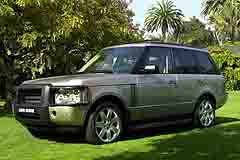
MSRP Range: $71,500
Invoice Range: $65,000
Price Quote
MSRP As Tested: $71,500
Versions: HSE
Vehicle Category: Full-Size Luxury Sport Utility Vehicle
Engine Location: Front Engine
Drive Wheels: All Wheel Drive
Engine As Tested: 4.4-liter, Dual Overhead Cam, V-8 cylinder, 282-horsepower at 5,400 rpm and 324 lb-ft torque at 3,600 rpm
Transmission As Tested: 5-Speed Automatic with manual shift option.
Fuel Economy (city/hwy): 12/17
Standard Safety Features: Driver and front passenger, front and side airbags, front and rear head-protection side airbags, 4-wheel disc brakes, "> Antilock Braking System, Front and Rear Traction Control, Antiskid System, Brake Assist, front- and rear-Obstacle Detection SystemHill Descent Control, Remote Keyless Entry, Tire-Pressure Monitor.
Competition: BMW X5, Cadillac Escalade, HUMMER H2, Infiniti FX45, Lexus LX 470, Lincoln Navigator, Mercedes-Benz G-Class, Mercedes-Benz M-Class, Porsche Cayenne, Toyota Land Cruiser, Volvo XC90.
The slope is 45 degrees. My instructor, Ken, tells me to drive over the edge and then take both feet off the brake and gas pedals. 'Just let it do its thing.' And the Range Rover eases us down the frightening slope at 2 1/2 miles per hour, in complete safety. My heart was racing at 20,000 rpm.
That was my introduction to off-roading, Range Rover style, as the British SUV manufacturer, owned by Ford Motor Company, introduced the motoring press to the 2003 Range Rover. This is only the third model in its over 30-year history.
The award winning 2003 Range Rover from Britain's Land Rover officially went on sale in late spring 2002, with most vehicles pre-sold. Since its world premiere in January 2002, more than 3,000 orders have been placed for the stunning new vehicle.
'We believe the new Range Rover is the world's most capable vehicle, with the greatest breadth of ability of any vehicle ever made,' said Bob Dover, Managing Director of Land Rover, and I can only agree.

After two days driving in and around Santa Barbara, my amazement as to how this extraordinary vehicle handles and feels was only eclipsed by the interior and the finish. The elegant cabin design is, simply put, revolutionary. The interior brings new levels of luxury to the class. A wide variety of styling and texture ideas, including elegant real woods and leathers, were taken from a diverse range of influences including luxury homes and yachts.
Throughout its 34-year history, Range Rover has consistently been recognized for possessing a combination of on- and off-road ability that is unique in the world. From the original two-door model that debuted in London, to critical acclaim, at Earl's Court Motor Show in 1970 to today's 2003 model, Range Rover is the world's finest 4x4. It provides its owners with both sure-footed capability off-road and all the comfortable refinement of the best European touring sedans on road. Range Rover has always been a vehicle for all reasons. Its popularity remains unyielding. Few other sport-utility vehicles have inspired such strong owner loyalty.
Range Rover's history dates back to the early 1960s when the management of the Rover Company (an organization that is today entirely separate from that of Land Rover) dabbled with the idea of producing a 'Road Rover.' The Road Rover was to be a civilized station-wagon version of the hearty, well-known and endlessly capable open-top Land Rover. While the Road Rover project never went into production, research from the program was used in the mid-1960s by Land Rover engineers Spen King and Gordon Bashford to help develop a V8-powered leisure vehicle.
The key to their prototype vehicle lay in its permanent four-wheel drive, low-rate coil spring suspension, exceptional wheel travel, four-wheel disc brakes and excellent visibility, known to Land Rover as the command driving position.
Dubbed 'Concept Oyster' during customer research, the vehicle that would eventually carry the name Range Rover had been developed with the North American market in mind from the start. The first running prototype was completed in the late summer of 1967. In 1968, the name Range Rover was formally adopted, with production beginning in March 1970. At launch, the vehicle was capable, rugged and carried a certain level of comfort and luxury that was previously unknown to Land Rovers.
For many years, Range Rover was kept apart from the other Land Rover vehicles. It seemed to be positioned above the other product, apart from its higher price, but things have changed. The new styling seen in this new Range Rover will be carried over to other product.
Back to driving. My first experience of Hill Descent Control was in the Discovery.

Hill Descent Control was invented by Land Rover, and is new to Range Rover. It operates in all gears, both forward and reverse, high and low. This is especially useful when an attempt to drive up a sand dune fails, creating a potentially precarious situation. Normally the braking force is on the front wheels. But you need it on the rear in order to back down under control. I was advised to 'just select reverse', and then Hill Descent Control. The algorithm is swapped around giving the braking force to the rear wheels, allowing you to reverse back down the slope safely. Now I'm not suggesting we all go out and find sand dunes to try this on, the state of California frowns on this, but if you need it, its there.
The Land Rover instructors set up a special test course so we could test the Range Rover and our off-road abilities. I'm glad to say we all passed.
In North America the new Range Rover is only available as one model, a high spec HSE. There is only one engine and drive train. The 4.4-liter motor is part of the development from Land Rover's four-year ownership by BMW. Designed and built in Germany it's the best motor ever fitted into a Range Rover, but for us purists it's sad to see the original Rover V8, a engine first developed in 1953, gone.

With a price of around $70,000 the Range Rover buyer is well defined. They are mostly male, mostly married and about half of them are in the empty nest stage. They are very well educated. They have a particularly low median age, 46, and are very wealthy, with a median income of around $280,000. Not surprisingly, dealers are not having a problem selling the vehicle. As one local dealer told me, 'We can't keep them on the lot. I've received four and they went the day they arrived.'
The 2003 Range Rover isn't for everyone. Yes it is a lot of money, but you get a lot of vehicle and you can take it just about anywhere, in comfort, safety and luxury.
The Range Rover is at Land Rover dealers now. If you want one and you haven't put down a deposit…Oh well!
Pros: Elegant vehicle that can be used daily with ease. It is comfortable, accomodating and very well constructed. It is a pleasure to drive. It is a one of a very small number of true off-roading production vehicles. The interior is very well appointed. There are loads of wonderful aftermarket products to accessorize it -- our favorite is the $5,000 + sleeping platform that attaches to the roof.
Cons: It is a member of the "gas guzzling, behemoth vehicle" category. Vehicles of this ilk should be thought carefully about before purchase because they over-consume both materials and fuel. The Range Rover will be very expensive to repair and maintain after the warrentee is over. Despite that people imagine they are giving the impression of being "a lover of the great outdoors" and "environmentally friendly" this vehicle is neither.
Ratings (1-10)
Style: 8
Performance: 8
Price: 7
Handling: 8
Ride: 9
Comfort: 9
Quality: 9
Overall: 8
MORE DATA
Where Built: England
Major Options: Heated front seats, heated rear seats, heatede steering wheel ($1,300.)
Seating: 5
Number of Rows: 2
Crash Test Ratings:
- NHTSA Frontal Impact/Driver Crash Test Rating: Untested
- NHTSA Frontal Impact/Passenger Crash Test Rating: Untested
- NHTSA Side Impact/Front Seat Crash Test Rating: Untested
- NHTSA Side Impact/Rear Seat Crash Test Rating: Untested
- NHTSA Rollover Resistance Rating: Untested
- IIHS Frontal Offset Crash Test: Untested
Length in Inches: 195.0
Warranties: 4 years/50,000 miles bumper-to-bumper, 6 years/unlimited miles corrosion, 4 years/50,000 miles free Roadside Assistance, 4 years/40,000 miles free Schedule Maintenance.
Weight in Pounds: 5,379
Towing Capacity in Pounds: 7,700
Gas Tank Capacity in Gallons: 26.4
Destination Charge: $665




